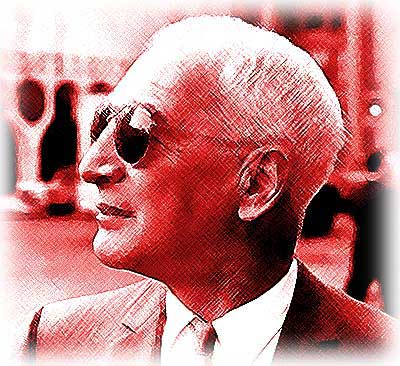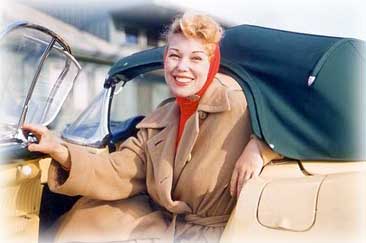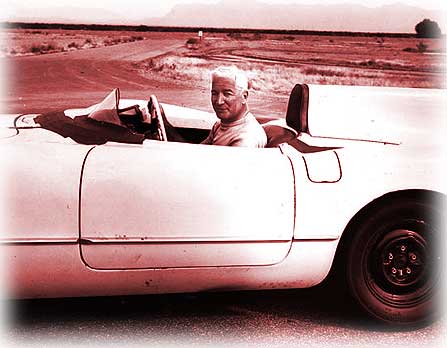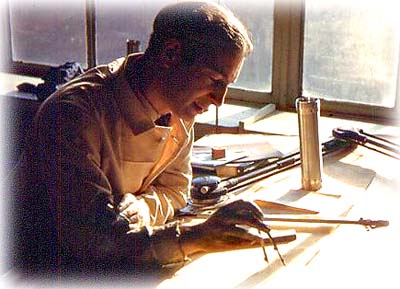Dateline: 12.25.11
Where the Corvette Got Its Mojo From!
 Don’t miss the Duntov video at the bottom of this post!
Don’t miss the Duntov video at the bottom of this post!
Corvettes are all about passion and that passion shows up in two powerful ways – visually and from performance. The two are so intrinsically connected that they seem one and the same, but a closer examination reveals that is not the case. Of course, the first thing one notices about the Corvette is its looks. The car’s appearance is totally unique, even though it did borrow a little here and there from other designs. But at the end of the day, the completed design only looks like a Corvette.
But looks will only get you so far. What completes the Corvette addiction is the visceral experience of driving one. To “get” the Corvette, you must drive the car. And if the driving experience was now much different from a mushy sedan, what’s the point? No, if the Corvette didn’t deliver responsive performance with gobs of sensory input for the driver, the car surely would have gone quietly into the night, fading into automotive obscurity, along with a long list of once interesting cars.
 So who was responsible for infusing the Corvette with it’s Mojo? Zora Arkus-Duntov. Zora was, without a doubt, the ultimate automotive corporate misfit to ever work in Detroit. By the time he saw the very first Corvette at the 1953 Motorama, he was 44 years old, a seasoned mechanical engineer, race car driver and builder. he was quoted as saying, “When I saw the Corvette at the Motorama, I thought it was the most beautiful car I’d ever seen.” And Duntov appreciated beauty. Just look at his stunning blond beauty wife and former Bluebell Girls dancer, Elfie Duntov. yes, Zora new a good-looking dame when he saw one and one look at the Corvette and he knew where he wanted to be – in the engineering department of Chevrolet, working on the Corvette.
So who was responsible for infusing the Corvette with it’s Mojo? Zora Arkus-Duntov. Zora was, without a doubt, the ultimate automotive corporate misfit to ever work in Detroit. By the time he saw the very first Corvette at the 1953 Motorama, he was 44 years old, a seasoned mechanical engineer, race car driver and builder. he was quoted as saying, “When I saw the Corvette at the Motorama, I thought it was the most beautiful car I’d ever seen.” And Duntov appreciated beauty. Just look at his stunning blond beauty wife and former Bluebell Girls dancer, Elfie Duntov. yes, Zora new a good-looking dame when he saw one and one look at the Corvette and he knew where he wanted to be – in the engineering department of Chevrolet, working on the Corvette.
After numerous letters to then chief of engineering at Chevrolet, Ed Cole, Zora was hired and assigned to work under Maurice Olley. Duntov may have had the beauty queen Corvette on his mind, by Olley tested the Russian’s metal by assigning him the glorious task of analyzing suspension options for a tail-heavy car. As far back as the late 40s, GM was looking into the possibility of a rear-engine car.
 When he finally was able to start working on the Corvette’s suspension, he was horrified at what’s he found once behind the wheel. For just driving around, the car’s sedan suspension and frame were okay. But under extreme cornering situations (exactly the kind of situations Zora liked) the car wanted to go every way except where the driver pointed it. For anything other than just tooling around, the car was a real wiggle wagon. The Corvette’s sedan frame was sufficient with a steel passenger car body bolted to it that added structural stiffness. But with a bolted on, flexible fiberglass body, the car was very unpredictable as a sports car. And after all, Chevrolet was trying to sell the Corvette as a “sports car.”
When he finally was able to start working on the Corvette’s suspension, he was horrified at what’s he found once behind the wheel. For just driving around, the car’s sedan suspension and frame were okay. But under extreme cornering situations (exactly the kind of situations Zora liked) the car wanted to go every way except where the driver pointed it. For anything other than just tooling around, the car was a real wiggle wagon. The Corvette’s sedan frame was sufficient with a steel passenger car body bolted to it that added structural stiffness. But with a bolted on, flexible fiberglass body, the car was very unpredictable as a sports car. And after all, Chevrolet was trying to sell the Corvette as a “sports car.”
So, that’s what Duntov started with – a very crude, but great-looking car. The best presentation of the life and times of Zora Arkus-Duntov is “Zora Arkus-Duntov – The Legend Behind Corvette” by Jerry Burton, published by Bentley Publishers, 2002. If you love Corvettes and are a Duntov fan, this is a MUST READ. The book shows consistent personality characteristics. He was a maverick, a rogue, sometimes a rake, a gorilla fighter, and VERY passionate. Today we’d call him a “high testosterone kind’a guy.” He also had a habit of making the best of what was. Example – Duntov was shocked at Olley’s confrontational management style, especially after Olley suggested Zora quit GM because he didn’t like Duntov’s non-engineering solution to his first assignment of sorting out the bad handling of a rear heavy car, which was to increase the rear tire inflation. Duntov’s solution worked, but Olley didn’t like it. The confrontation was such that Zora actually thought about leaving GM, but reconsidered that decision after considering what it took to get hired.
 Another example was the styling of the C2 Sting Ray. He flat out didn’t like it and let GM’s VP chief of styling know about it, which resulted in a classic blowup between the brilliant, but egocentric Mitchell and the passionate Duntov that only wanted the driver to be able to clearly see where he was steering the car. If Duntov had his way, the Corvette would have looked more like a Porsche! Obviously, Zora lost their famous shouting match (Mitchell called Zora “Zorro” and Duntov called Mitchell a red-faced baboon!) But Duntov made the best of the situation, picked his battles, and focused his energy on making the Sting Ray as much of a bad-ass as he could.
Another example was the styling of the C2 Sting Ray. He flat out didn’t like it and let GM’s VP chief of styling know about it, which resulted in a classic blowup between the brilliant, but egocentric Mitchell and the passionate Duntov that only wanted the driver to be able to clearly see where he was steering the car. If Duntov had his way, the Corvette would have looked more like a Porsche! Obviously, Zora lost their famous shouting match (Mitchell called Zora “Zorro” and Duntov called Mitchell a red-faced baboon!) But Duntov made the best of the situation, picked his battles, and focused his energy on making the Sting Ray as much of a bad-ass as he could.
No, there never had been and probably never will be anyone working in Detroit like Zora Arkus-Duntov ever again. A more subtle aspect of Burton’s book is that despite the freewheeling, swashbuckling style of men such as Bill Mitchell, Ed Cole, and Zora Duntov, even back in the olden, golden days of Chevrolet’s performance status, General Motors was just as stodgy, cranky, ornery, and difficult as anything we’ve seen in recent years.
 While it is true that Duntov did not invent the Corvette and wasn’t responsible for the car’s brilliant styling, he infused a passion into the Corvette’s soul that lives on in every Corvette from the C6.R Le Mans-winning race cars to the base model cars. If the passion wasn’t there, we wouldn’t be talking right now. Duntov died on April 21, 1996, at the age of 87. If he was still around, I’m certain he’s be thrilled with what his successors have done with the car. HAPPY BIRTHDAY, Zora! – Scott
While it is true that Duntov did not invent the Corvette and wasn’t responsible for the car’s brilliant styling, he infused a passion into the Corvette’s soul that lives on in every Corvette from the C6.R Le Mans-winning race cars to the base model cars. If the passion wasn’t there, we wouldn’t be talking right now. Duntov died on April 21, 1996, at the age of 87. If he was still around, I’m certain he’s be thrilled with what his successors have done with the car. HAPPY BIRTHDAY, Zora! – Scott
Related:
Zora Speaks! Zora Arkus-Duntov’s Last Public Interview
Zora Arkus-Duntov LIVES… On Facebook!!!
Interview with Zora Arkus-Duntov Biographer, Jerry Burton
Here’s the BEST way to keep up with K. Scott Teeters’ Corvette blog!


